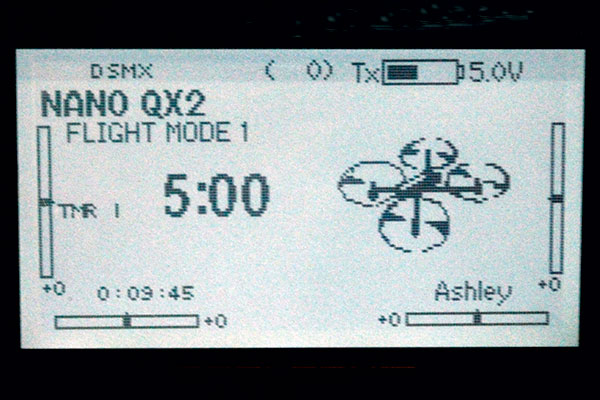Spektrum DX6e Transmitter

New products that are Worth a Closer Look Product spotlight As seen in the April 2017 issue of Model Aviation.
Specifications:
Type: Six-channel 2.4 GHz transmitter Frequency: 2.4 GHz Modulation: DSM2/DSMX Input power: Four AA batteries Display: High-resolution backlit LCD Number of channels: Six Price: $149.99; $179.99 with receiverFeatures:
• Wireless trainer link • Seven airplane wing types and six tail types • Four sailplane wing types and three tail types • Two swashplate types • Multirotor flight mode setup • Lap timer switch • SD card support • Adjustable antenna • Spring configuration switch • Four model types • Built-in telemetry • Four AA batteries included • Cross-platform model sharing with other Spektrum transmittersSpektrum’s DX6e is the latest low-price, big-feature transmitter in its lineup. The transmitter is available with or without an AR610 receiver. The box also includes four AA batteries to power the transmitter and a 179-page manual featuring instructions in four languages. For less than $200, you get a six-channel radio with 250-model memory, SD card support, and a wireless trainer link. The menu system is in the same format as higher-dollar DX transmitters and gives you many of the same programming options. The DX6e is programmable for airplanes, helicopters, sailplanes, and multirotors. The airplane program contains seven wing and six tail types. The helicopter program has two swashplate types to choose from and the sailplane contains four wing and three tail types. A special feature of the DX6e is the multirotor aircraft option. This is a feature that most radios do not have. If you have a lot of interest in flying multirotors, this is the perfect starter transmitter for you. The 250-model memory can be programmed with the name of each aircraft for easy identification, as well as the freedom to reorder the model listing to keep your favorites toward the top of the list and easy to find. There are also options for deleting models, copying models, resetting models, and the ability to program a warning tone that sounds if a switch or control stick is in an unsafe position when the transmitter is powered on. I only have one model bound to my transmitter (a Blade Nano QX2), so I haven’t yet taken advantage of most of these features. The Spring Configuration Switch is new to this transmitter and is patent pending. This innovation allows you to change flight modes on your radio without needing to remove its back to make the adjustments. All you need to do is access the flight modes in the system settings menu and set the mode you need. Power off the transmitter and then move the slider switch found on the back of the transmitter. After the switch is moved to the desired mode, power the transmitter back on and it’s ready to go.

The DX6e has a slot on the bottom that accepts an SD card. This SD card can be used to save and share models, as well as update your firmware. This transmitter had cross-platform sharing with all other Spektrum radios, so you can fly your models on more than one transmitter if desired. Ratchets and spring controls for stick adjustments are found on the front of the radio. You can change the length of the control sticks, the smoothness of the throttle movements, and the stick tension. There are two ways to bind a model to the DX6e. The first is to power on the receiver before turning on the transmitter. Make sure the throttle is in the lowest position. While pressing the Bind button on the back of the transmitter, power it on. After the receiver has stopped flashing, release the Bind button. The second binding method allows you to leave the transmitter on. If you are programming new models into your model memory, there is a Bind option in the system setup menu. Dual rates and exponential programming are standard to the Spektrum DX transmitters. There is also an option to track aircraft performance through an optional telemetry module and sensors. A monitor screen can be accessed quickly by moving the scroll wheel to the right. Here you can see the servo positions for which your channels are set. This can also be helpful in the event that you start to experience a loss in control of any of your channels. After returning your model to the ground, this menu can be used to show if your controls are getting input when moving the sticks. If they are, then it proves whatever issues you are experiencing are not on the transmitter’s end. The wireless trainer feature lets you perform buddy-box flying without a cord getting in the way. The trainer feature will bind to any other DSMX or DSMX2 transmitter. When bound, the radios will stay linked and there is no need to rebind each time they are used together. Another great feature of this transmitter is the lap timer. There is a built-in timer in the functions menu that can be programmed to track your flight laps. This can be especially beneficial for multirotor racing. This really is a fully programmable transmitter. There are so many options that they can’t all be covered here. This is a great transmitter for an exceptional value. It might be geared toward the beginner, but pilots of any skill level can enjoy flying with the Spektrum DX6e in control. Horizon Hobby: 4105 Fieldstone Rd. Champaign IL 61822 Tel.: (800) 338-4639 website: www.horizonhobby.com










1 comments
Price: $149.99; $179.99 with receiver
Add new comment